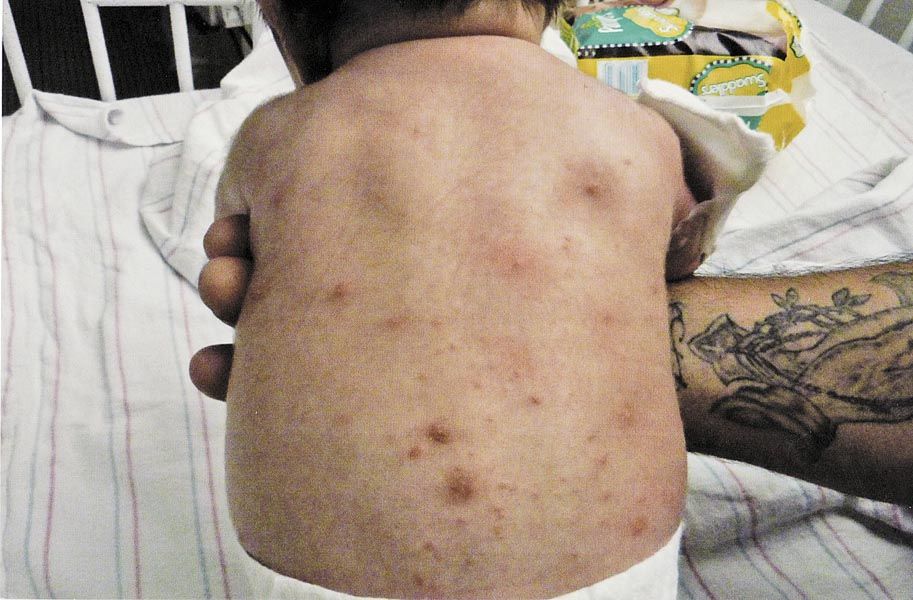Infant with a persistent nodular skin rash
The worried mother of a 4-week-old boy brings her son to you for evaluation of a rash that started 3 weeks ago on his left eyebrow and chest, then spread to his back, arms, and legs despite treatment with topical steroids. What’s your diagnosis?

The Case
The worried mother of a 4-week-old boy brings her son to you for evaluation of a rash that started 3 weeks ago on his left eyebrow and chest, then spread to his back, arms, and legs despite treatment with topical steroids. What’s your diagnosis?
Diagnosis: Infantile nodular scabies
Clinical findings and etiology
Scabies is a contagious disorder caused by the itch mite Sarcoptes scabiei that infests infants and children as well as adults. The eruption in scabies presents with distinctive pruritic papules, vesicles, and linear burrows.1 Unfortunately, many patients do not present this classic picture but rather a mixture of primary lesions intermingled with or camouflaged by excoriations, eczematization, crusting, and/or secondary infection. The severe itching accompanying scabies takes 4 to 6 weeks to develop and is believed to be related to a type 4 hypersensitivity reaction. Before sensitization occurs, scabies burrows may not be brought to the attention of the practitioner because symptoms may be minimal.
In infants and young children, the distribution may include palms, soles, head, neck, and face.2 The burrow, considered a pathognomic sign of scabies, unfortunately is demonstrable in only 7% to 13% of adults. In newborns and infants who are not particularly effective scratchers, nonspecific symptoms such as poor feeding or increased fussiness may not raise clinical suspicion.
Many infants and young children who develop scabies also develop persistent reddish brown infiltrated nodules, or nodular scabies, in skin creases and covered parts of the body (the axillae, shoulders, groin, buttocks, and genital area).1 These lesions represent a hypersensitivity reaction to the scabies mite and may persist for months despite therapy. Nodular scabies may be mistaken for persistent scabies infestation, resulting in unnecessary treatment with scabicides. Skin biopsy of these lesions may be misdiagnosed as incontinentia pigmenti, insect bite hypersensitivity, contact dermatitis, histiocytosis, or lymphoma. The diagnosis is mainly clinical and based on finding scabies among the patient’s family, identification of burrows, and finding viable mites on microscopic examination of skin scrapings.
Treatment
The management of scabies usually involves application of topical scabicide cream to all areas except the face and removal in 8 to 48 hours depending on the agent. The agent of choice for infants, young children, and pregnant or nursing women is 5% permethrin cream (not approved for children aged younger than 2 months) applied to the entire head, neck, and body of the infant.1 All family members should be treated simultaneously. Two (or more) applications, each about a week apart, may be necessary to eliminate all mites, particularly when treating crusted (Norwegian) scabies.2
Although lindane 1% cream is still available in the United States, the US Food and Drug Administration recommends against its use in children and the elderly, and it is banned in California. Failure rates with topical 10% crotamiton cream are unacceptably high. Off-label studies with oral and topical ivermectin suggest that this agent may be an effective and safe alternative, especially for crusted scabies.2-4 Single application for 5% permethrin cream has been shown to have a cure rate between 89% and 92% per various studies.4 Antibiotics may be necessary to treat secondary infection.3
Clothing and bedding should be machine washed in hot water.1,2 Insecticidal powder or aerosol should be reserved for materials that cannot be washed.1 Pruritus usually persists for 4 to 6 weeks after successful treatment with a scabicide and may be relieved by bland emollients, bedtime oral antihistamine, or tapering topical steroids. Children should be allowed to return to child care or school after treatment has been completed.
Our patient
Our patient was admitted to the hospital for fever and concern for disseminated herpes simplex virus and bacterial infection, and started on parenteral antibiotics and acyclovir. His parents and siblings were subsequently noted to have an itchy rash, and scabies was suspected. After 3 days of negative cultures, our patient and his family were treated with 5% permethrin cream. Antibiotics and acyclovir were discontinued and he was discharged home.
REFERENCES
1. American Academy of Pediatrics. Scabies. In: Pickering LK, Baker CJ, Kimberlin DW, Long SS, eds. Red Book: 2009 Report of the Committee on Infectious Diseases. 28th ed. Elk Grove Village, IL: American Academy of Pediatrics; 2009:589-591.
2. Centers for Disease Control and Prevention. Parasites-Scabies. http://www.cdc.gov/parasites/scabies. Reviewed November 2, 2010. Accessed December 12, 2013.
3. Bartlett JG, Auwaerter PG, Pham PA. Johns HopkinsABX Guide: Diagnosis and Treatment of Infectious Diseases. 3rd ed. Burlington, MA: Jones and Bartlett Learning; 2012.
4. Strong M, Johnstone P. Interventions for treating scabies. Cochrane Database Syst Rev. 2007;(3):CD000320.
DR DAS is assistant professor, Department of Pediatrics, University of Nevada School of Medicine, Las Vegas. DR PATAMASUCON is professor, Department of Pediatrics, University of Nevada School of Medicine, Las Vegas. DR COHEN, the section editor for Dermatology: What’s Your DX?, is director, Pediatric Dermatology and Cutaneous Laser Center, and associate professor of pediatrics and dermatology, Johns Hopkins University School of Medicine, Baltimore, Maryland. The authors and section editor have nothing to disclose in regard to affiliations with or financial interests in any organizations that may have an interest in any part of this article. Vignettes are based on real cases that have been modified to allow the authors and editor to focus on key teaching points. Images also may be edited or substituted for teaching purposes.
Recognize & Refer: Hemangiomas in pediatrics
July 17th 2019Contemporary Pediatrics sits down exclusively with Sheila Fallon Friedlander, MD, a professor dermatology and pediatrics, to discuss the one key condition for which she believes community pediatricians should be especially aware-hemangiomas.